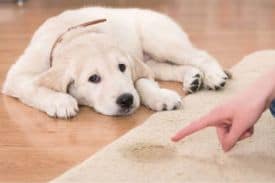Potty training a dog can sometimes feel like navigating through a dense forest without a map. However, this seemingly daunting task can be accomplished with the right guidance and approach. Just as a compass guides lost explorers, understanding your dog’s behavior and needs is crucial in potty training.
In this article, we will delve into the intricacies of potty training your furry friend and provide you with effective strategies to ensure success. By establishing a consistent routine, choosing an appropriate designated potty area, using positive reinforcement techniques, carefully supervising your dog’s behavior, and properly cleaning up accidents, you will lay the foundation for successful potty training.
We understand that serving our audience means equipping them with practical knowledge to enhance their relationship with their dogs. Therefore, patience and consistency will be key throughout this journey toward achieving better bathroom habits for your canine companion.
Remember that seeking professional help when necessary is not a sign of weakness but rather an act of responsible pet ownership.
Let us embark on this adventure together as we celebrate every small triumph while maintaining good habits for you and your beloved four-legged friend.
Key Takeaways
- Understanding your dog’s behavior and needs is crucial in potty training.
- Establishing a consistent routine is important in potty training.
- Positive reinforcement techniques such as treats and praise should be used.
- Choosing a designated potty area helps establish consistency.
Understand Your Dog’s Behavior and Needs

Understanding your dog’s behavior and needs is essential to successfully potty training them. By delving into dog psychology, one can gain insights into their pet’s instincts and tendencies.
Dogs inherently desire to keep their living space clean and instinctively avoid soiling areas where they eat or sleep. This understanding can help owners establish a routine for regular bathroom breaks, minimizing accidents.
Additionally, identifying common potty training challenges, such as marking territory or submissive urination, can further address these issues effectively. Recognizing the signs of anxiety or discomfort in dogs during the potty training process allows owners to provide appropriate support and reassurance, fostering a positive learning environment for their furry companions.
Establish a Routine and Stick to It

Establishing a consistent daily schedule for your furry companion is crucial in successfully teaching them proper toileting habits, as it provides structure and helps them develop a sense of routine akin to our daily rituals.
Dogs thrive on predictability, and having a set way allows them to anticipate when to go outside. Consider your dog’s age, breed, and individual needs when creating a schedule. Potty breaks should be scheduled after meals, naps, playtime, and waking up in the morning or from a nap.
Additionally, consistency extends to training methods. Positive reinforcement techniques such as treats and praise can reward desired behavior. Avoid punishment-based ways that may confuse or frighten your dog.
Establishing a routine and using positive training methods consistently will help your dog develop good potty habits effectively while promoting their well-being.
| Pros | Cons |
|---|---|
| Provides structure | Requires commitment |
| Promotes predictability | Time-consuming initially |
| Builds trust between owner and pet | It may require adjustments over time |
Choose a Designated Potty Area

One important aspect of ensuring proper toileting habits in your furry companion is selecting a specific area where they can relieve themselves.
Choosing a designated potty area for your dog can have several benefits. One option is a potty pad, which provides an easily accessible and convenient spot for your dog to eliminate. Potty pads are handy for owners living in apartments with limited outdoor space. They also help establish consistency in your dog’s toileting routine by providing a consistent location for them to go.
Additionally, regular exercise is crucial in potty training as it helps stimulate bowel movements and encourages bladder control. Adequate exercise ensures your dog can eliminate waste before accidents occur inside the house.
You can teach your dog proper toileting habits by incorporating a designated potty area and regular exercise into your potty training routine.
Use Positive Reinforcement and Rewards
Positive reinforcement and rewards can effectively promote desired behaviors in pets, as they provide motivation and encourage repetition.
When potty training a dog, positive reinforcement can help establish a strong association between going to the designated area and receiving a reward.
This method involves praising and rewarding the dog immediately after they successfully eliminate it in the correct spot. The reward could be a small treat, verbal praise, or even a favorite toy.
It is important to use positive reinforcement consistently and immediately following the desired behavior to reinforce the connection.
Patience is key for stubborn dogs who may take longer to grasp potty training concepts. Consistency, persistence, and positive reinforcement are crucial when dealing with stubborn dogs during their potty training journey.
Supervise and Monitor Your Dog’s Behavior
Supervision and monitoring a pet’s behavior is essential to ensure successful conditioning and reinforcement of desired habits.
When potty training a dog, effective techniques involve closely observing their actions and providing immediate feedback. By closely monitoring your dog, you can identify signs they need to eliminate and guide them toward the appropriate spot. It is important to interrupt any undesired behavior promptly and redirect them to the designated area for elimination.
Consistency in supervision helps reinforce the association between the desired behavior and the designated location for elimination. Furthermore, monitoring your dog’s behavior allows you to track progress, identify patterns, and adjust training methods.
Ultimately, proper supervision is crucial in establishing good potty training habits in dogs by utilizing effective dog training techniques.
Use Crate Training as a Tool
Utilizing crate training as a method can be effective in facilitating the establishment of desired habits in canine elimination.
Crate training benefits include providing a safe and secure space for the dog, preventing accidents in the house, and aiding in developing bladder control.
This method also helps create a routine for the dog’s bathroom breaks, which is essential for successful potty training.
However, it is important to note that crate training may not be suitable for every dog or owner.
Some alternatives are using puppy pads or paper training, creating a designated outdoor potty area with proper barriers, or utilizing a doggy door for independent access to an outdoor space.
Each alternative has advantages and disadvantages, so choosing the best method that suits your dog’s needs and lifestyle is crucial.
Clean Up Accidents Properly
To effectively address accidents, it is crucial to implement proper cleaning methods that thoroughly eliminate any lingering odors or stains. Proper cleaning techniques are essential for maintaining a hygienic environment and preventing future accidents.
When dealing with dog urine or feces, acting promptly and using enzymatic cleaners specifically designed for pet messes is important. These cleaners contain enzymes that break down the organic compounds responsible for odors and stains.
Begin by blotting up any excess liquid with paper towels, then apply the enzymatic cleaner according to the instructions on the label. Allow the cleaner to sit for an appropriate amount of time before blotting it up again.
Avoid using ammonia-based cleaners, as they can encourage dogs to mark in the same spot again. Additionally, consider using deterrent sprays or other preventive measures in areas where accidents have occurred previously, such as puppy pads or training aids, to discourage future incidents.
Following these proper cleaning techniques and taking preventive measures can effectively clean up accidents and create a more sanitary environment while reducing the likelihood of future mishaps.
Be Patient and Consistent
Being patient and consistent is key when successfully teaching your furry companion appropriate bathroom habits, with research showing that it can take an average of six months for a dog to fully adjust to a new routine.
Training challenges may arise during this process, but it is important to stay calm and persistent. One common mistake pet owners make is punishing their dogs for accidents. This can create fear and anxiety in the dog, making potty training even more difficult.
Instead, focus on positive reinforcement by rewarding your dog whenever they eliminate it in the designated area. Consistency is also crucial in establishing a routine. Take your dog outside regularly throughout the day, and be patient with them as they learn.
Being patient and consistent will help your furry friend develop good bathroom habits that will serve both of you well in the long run.
| Training Challenges | Common Mistakes |
|---|---|
| Accidents | Punishing |
| Fear | Inconsistency |
| Anxiety | Lack of patience |
| Resistance | Ignoring signs |
| Distractions | Inadequate supervision |
Seek Professional Help if Needed
If you are facing difficulties while establishing appropriate bathroom habits for your furry companion, seeking professional assistance can be a beneficial step toward overcoming any challenges.
Knowing when to consider professional help is crucial in ensuring your dog receives the necessary guidance and support. If your dog consistently fails to make progress despite consistent training efforts, or if you are unsure about the best approach to potty training, it may be time to seek expert advice.
The benefits of seeking professional guidance include gaining access to experienced trainers who deeply understand canine behavior and effective training techniques. They can provide personalized strategies tailored to your situation, helping you address any underlying issues hindering successful potty training.
Seeking professional help can greatly increase the likelihood of achieving positive results and creating a harmonious living environment for you and your beloved pet.
Celebrate Success and Maintain Good Habits
Maintaining consistent and positive reinforcement of desired behaviors in the bathroom can lead to a sense of accomplishment and perpetuation of good habits. Celebrating success during potty training is crucial to motivate and encourage your dog to continue its progress.
Here are five tips to help you maintain good habits and deal with setbacks:
- Establish a routine: Stick to a regular schedule for feeding, walking, and bathroom breaks.
- Use rewards: Offer treats or praise when your dog goes potty outside.
- Supervise closely: Keep an eye on your dog at all times, especially during the initial stages of potty training.
- Be patient: Understand that accidents may happen occasionally, but remain calm and consistent in your approach.
- Clean up accidents properly: Use enzymatic cleaners to eliminate odors and prevent repeat incidents.
Following these guidelines makes maintaining consistency easier while effectively dealing with setbacks that may occur during the potty training process.
Frequently Asked Questions
Can I use punishment methods to potty train my dog?
Using punishment methods for potty training dogs is not recommended, as it can lead to negative consequences such as fear and anxiety. Effective alternatives include positive reinforcement, consistency in routine, and supervision to prevent accidents.
How long does it usually take to potty train a dog?
The duration of potty training for dogs varies depending on factors such as breed, age, and consistency in training. Common challenges include accidents, resistance to designated areas, and difficulty understanding commands. Tips to expedite the process include establishing a routine, positive reinforcement, and consistent supervision.
What if my dog refuses to go to the designated potty area?
In cases where dogs refuse to use the designated potty area, alternative potty training methods can be explored. Additionally, dealing with accidents inside the house requires patience, consistency, and positive reinforcement techniques.
Should I use potty training pads or take my dog outside to eliminate it?
Using potty training pads for indoor elimination has pros, such as convenience and ease of cleaning. However, it may create dependency and make transitioning to outdoor elimination more challenging. Tips for a successful transition include gradually reducing the reliance on pads and providing positive reinforcement for outdoor elimination.
Is it necessary to crate-train my dog during the potty training process?
Crate training is not necessary during the dog potty training process. However, it can be useful to prevent accidents and establish a routine. Other effective dog potty training tips include consistency, positive reinforcement, and frequent outdoor trips.
Conclusion
In conclusion, the journey of potty training your canine companion can be filled with surprises, joy, and occasional slip-ups, but the reward of a well-trained pup is priceless.
At Bone Voyage Dog Rescue, we believe every dog deserves a second chance and a loving home where they’re properly nurtured regardless of age or background. We hope this guide is a valuable tool for your pet parenthood journey.
If you’re considering adding a four-legged friend to your family, why not explore the possibility of adoption? Our rescue dogs are waiting to embark on an unforgettable journey with you – one that begins with a simple ‘sit’ and progresses to a fully house-trained companion.
Make a difference today – adopt, don’t shop. Visit Bone Voyage Dog Rescue, where love and new beginnings are a wag away.
